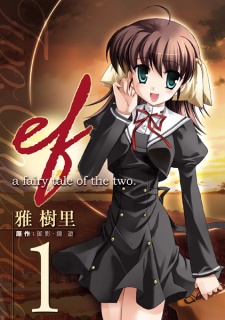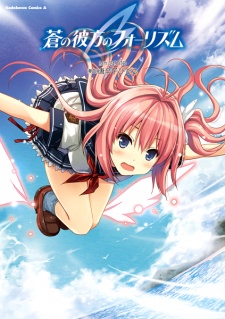Jul 29, 2011
- ". . . Yuu-kun is the same as always, (hee hee)
That straightforward personality."
- "People do not change that easily."
- "That is true.
. . . I have
Lost many things,
But . . .
After I met those children,
I have also found many new things."
- "The stories about the children Yuuko has met . . .
...
Can you tell me more?"
- "Yes."
I have reviewed both seasons of the anime and now I am getting to my manga version. The reason why Ef - a Fairy Tale of the Two. has a special place in my heart is because it focuses on the First Tale, which is about my favorite part the "saga," if you will, the love triangle of Hirono Hiro, Miyamura Miyako and Shindou Kei (some of the main characters of the first season), whose story felt rushed in the anime, mainly due to time constrictions (the season is twelve episodes long) and the inclusion of the Latter Tale at the same time. Hence, the manga takes it more slowly and is more detailed, giving logical, believable development between the characters. I will leave the comparisons at that for now as I give light on the synopsis to the unlucky ones who have no idea what I am talking about.
Hirono Hiro is a high school student who is also a shoujo manga artist (ironic, since I hate shoujo manga) unbeknownst to anyone but his childhood friend, Shindou Kei, as he goes under the name Shindou Nagi. One fateful Christmas night, Hiro decides to visit a church in order to help him with his artwork. There, he meets a mysterious woman who calls herself Amamiya Yuuko. She tells him that mass has already ended, to which Hirono replied that he is not there for it. He then proceeds to ask her if she is affiliated with the church, but she says she is not. Yuuko explains that she is waiting for someone. As Hirono is about to depart, Amamiya wishes him a merry Christmas. Outside, a girl's purse is stolen by a man on a motorcycle. She, Miyamura Miyako, sees Hiro, after he left the church, standing and asks him where the thief headed. Once Hiro answers Miyako, she thanks him and abruptly "borrows" his bicycle. As she chases the robber, Hirono chases Miyamura on foot. She eventually crashes. Miyako wakes up safely, and promises to pay Hiro back for the bicycle later. It turns out later that they both go to the same high school, called Otowa. A friendship develops between the two, disturbing a jealous Shindou, and Amamiya sometimes suddenly appears before Hirono and Miyamura separately, giving them advice. Time is drawing near for Kei to express her true feelings for her onii-chan, as she fully intends to win the war that is inevitable to begin against Miyako for the sake of her love, Hiro, who needs to carry upon his back his commitments for education, work, and these two young maidens . . .
People may come down hard on a premise such as this one, calling it annoying names like "typical," "overdone," and "cliche," but I prefer not to do that, in general. I see the essence in each story, and if you look closely, you will notice they are not that similar; there is always a unique factor separating them, be it the heroine killing the protagonist in the end, for the heroine's rival to go to a different school while still dating the protagonist, the heroine being an empty can ("WTF?"), the protagonist living under the heroine in a girl's dorm, or having three dots on the heroine and mention that she is from a planet called Seiren. Ef - a Fairy Tale of the Two. stands out as well because of Amamiya Yuuko, and the "person" she is waiting for, but I am actually glad it does not concentrate much on that part of the story, leaving most of the room for the love triangle and the characters' emotions.
Like I was saying earlier, the manga takes a slower pace than its anime counterpart, and there are noticeable differences. For example, when Hiro and Miyako first meet, in the anime, they spend the night together (I meant they go to karaoke and a family restaurant off-screen; get your mind out of the gutter) until morning, since her key was in her snatched purse, whereas in the manga, they just exchange information and go home separately, which is understandable, considering the varying time the two characters have with each other in both versions. Also, in Ef - a Fairy Tale of the Two., the three lead characters, along with Hirono's classmate, Tsutsumi Kyousuke, go out on a picnic (which is a very funny scene), something, again, Ef - a Tale of Memories. never gets to. Moreover, Kei is respectful towards Kyousuke, unlike in the first season of the anime, where their initial meeting ends up with the former punching the latter. Most noteworthy, however, is that the manga, despite having its share of drama, is more directed towards simplicity and comedy, in contrast to the anime's more serious and philosophical attitude, especially concerning Yuuko, who has casual conversations with and touches those she speaks with in the former version, but usually shows up in what seems to be dreams and has a somber disposition in the latter.
“Two. Only, Two.”
The characters are all wonderful, making this the amazing story that it is. There is Hirono Hiro, who tries to do what he wants despite the difficulties he faces, such as leaving home and injuring his right wrist from working a lot, gathered with school attendance and endless deadlines, but he likes to go to the roof of Otowa alone, having been given the key by his onee-chan, who studies in America, not knowing of her brother's profession. Miyamura Miyako is an eccentric girl, who, like Hiro, does not attend classes much, thinking they are boring, yet, despite that, being popular among the boys because of her beauty, athletic abilities, and intelligence (in tests), all while trying not to open up to anyone. Shindou Kei is Hiro's short-tempered childhood friend, who is the best freshman in the basketball team and a bad cook (much to her onii-chan's dismay); she keeps her feelings hidden from Hirono because of an incident of the past regarding her twin sister, Shindou Chihiro (the heroine of the Latter Tale). There is also Hiro's classmate, Tsutsumi Kyousuke, who goes to the film studies club; he helps his friend sneak out of school in return for the latter treating the former, something Kyousuke really holds on to, and used to talk a lot with Miyako in the past year, although she now has no idea who he is. Hayama Mizuki idolizes Kei, calling her "senpai," despite being in the same year (and basketball team); she is harsh on anyone who hurts Kei, even if she were not sure of the person's identity (of course, Hiro, again, is the obvious target). Lastly, Amamiya Yuuko is a person who gives advice to Hiro and Miyako, appearing out of nowhere; she has a light-hearted personality (though even she gets aggravated by Miyako, showing a different face after being called "mommy" jokingly, scaring the latter) and says her job is to "take care of anyone's needs," giving Hiro some strange ideas.
Art-wise, the anime is arguably superior, being, in my opinion, the best animated television show, but to be fair, compared to manga, far more people work on anime. The artwork in Ef - a Fairy Tale of the Two. is still great, though, and every chapter has its own cover page. I just do not like how the characters are drawn sometimes when they are disgusted or angry, being nose-less and having a stain-like spot on their faces.
In conclusion, this a romantic tale at its best, dealing with impeccable characters and hard decisions, when a man has to choose one of two girls he cares deeply about. This is by far my most favorite manga. There are profound lessons to be learned here, such as how loving someone can change you and your goals.
- "Just watching other people giving their all while standing on the sidelines is unacceptable."
- ". . . . . ."
- "To be honest, people who work hard at what they do will never except those who do nothing.
At least, I would never love a person like that."
- "Eh . . .? Why . . .
Why do I feel as if I were pierced by something?"
Reviewer’s Rating: 10
What did you think of this review?
Nice
 0
0
Love it
 0
0
Funny
 0
0
Confusing
 0
0
Well-written
 0
0
Creative
 0
0Show all

























